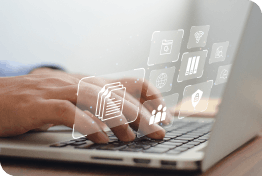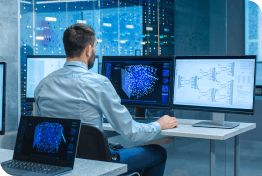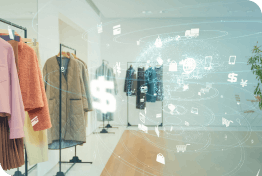- Physical security
4 ways to future-proof your retail security system
Unmanned stores and frictionless shopping present new challenges for retailers. To successfully meet those challenges, retail security systems in 2023 need to be able to do more than "just" ensure store, employee, and customer safety. Fortunately, security systems today come with various technologies and features that help retailers improve store security, streamline retail operations, and run a future-proof business.
1. Centralize operations with a unified platform
Digitalization has ushered in a new era of hosted security platforms that outshine the limited capabilities of legacy and analog retail security systems. They are at the core of the digital transformation in physical security for retail and power new AI-based solutions like proactive monitoring, false alarm detection, and video analytics – all of which make security systems more efficient than ever.
After all, it’s mission-critical for security teams to see the big picture of the area they need to secure. Today, this is made possible by integrated systems and unified platforms. To choose the right retail security system, you should know the difference between these systems.
Since they support legacy systems, integrated systems require maintenance and strain on your IT resources. They also require training for users to operate each system because each part of an integrated system has its interface.
The unified view provided by a physical security solution that links multiple types of data, such as POS exceptions and video surveillance, allows security teams to investigate suspicious activity quickly. With access to real-time data and dynamic visual reports, operators can better respond to incidents. If necessary, these reports can easily be shared with law enforcement. A visual dashboard can help you access and match video footage to incidents, like linking a suspicious refund transaction to a video that does not show a customer at the register. Instead of manually searching all flagged transactions for the associated video, you can view the specific transaction and the corresponding video. This greatly increases your security efficiency.
Unified platforms simplify day-to-day operations by eliminating the need for multiple logins. They also require less training because security teams only need to be familiar with one platform. Unified security software is handy for retailers with multiple locations because it can be easily scaled up to manage multiple stores from a single device. More stores can be added as the business grows.
2. Reduce false alarms with smart video alarm verification
Video verification integrates the signals from your traditional retail security system with video surveillance of the event that triggers an alarm in your shop. Combining signals from intrusion detection devices, live videos, and recently recorded clips, you can have a quick birds-eye view over the security status of all stores and check the status of alarms on the go: Using wireless technology and networks allows you to customize, monitor, and manage your retail security system anywhere, anytime, simply from your mobile phone. Rather than relying on signals of “blind” sensors, this is how modern CCTV equipment’s motion detection features let you quickly detect any undesirable presence in your store in the view range of your security cameras.

If your alarms are monitored by an outside security company, such as a control center, your retail security system will forward all triggered alarms to a professional security team. This leaves you with more time to focus on your shop operations. Integrating your store operation’s alarm management with automation and enhanced video analytics helps control centers be more aware when processing alarms from retail security cameras. Many integrations are available for intelligent alarm management by evalink, like Sitasys and Partizan built, allowing control centers to analyze videos from security cameras from a single platform.
We recommend choosing a certified, trusted provider to build a reliable security system for your business. It enables you to seamlessly integrate video verification in your alarm management so you can proactively respond to intrusions and other events requiring quick escalation.
3. Scale up your retail security system with cloud benefits
Since physical security devices like video cameras now rely on cloud network connectivity, physical and IT security are blending. The combination of physical and digital, known as "phygital," can enhance the retail experience: Retailers that effectively expand their physical security capabilities and integrate them with their knowledge of the cloud, networked systems, and the Internet of Things (IoT) will be able to grow their business opportunities and pass benefits on to their customers.
A cloud-based retail security system that is flexible and able to scale with your business is the best choice to be future-proof. When migrating to the cloud, you need a solution that will work for you today, in six months, a year, and five years from now. Unified security platforms usually come with an open architecture. Because it is highly flexible and non-proprietary, any software you choose will be compatible. And since you can't know how your retail business will evolve, an open, cloud-based security platform guarantees that you can swap out or add technologies that meet your store's needs without starting from scratch.
Retail owners can benefit from understanding the advantages of cloud-based physical security solutions like Video Surveillance as a Service (VSaaS) and Access Control as a Service (ACaaS), both belonging to the same family of edge devices managed via the cloud. Working with a vendor that supports them in learning about the benefits of physical security in the cloud can empower retailers to expand their capabilities and market influence while creating more value for their customers.
Video Surveillance as a Service (VSaaS)
Video Surveillance as a Service (VSaaS) refers to hosted, cloud-based video surveillance.
When you choose VSaaS for your retail security system, your video-based security system hardware and software are hosted in the cloud. That way, you can access your IP cameras from any device and have video footage at your fingertips wherever you are. Since your retail security data is securely stored in the cloud, you don’t need on-premises servers, hard drives, or other hardware like bulky, expensive Digital Video Recorder (DVR) and Network Video Recorder (NVR) systems anymore.
With VSaaS, you can access your video surveillance and camera footage anywhere at any time without needing physical equipment. Since all recordings are stored in the cloud, you don't need to be on-site to view the video footage from your security cameras. Instead, you can easily view it wherever you are.
Access Control as a Service (ACaaS)
Access Control as a Service (ACaaS) combines SaaS with on-premises access control devices. Like VSaaS, it's a cloud-based solution that allows retailers to remotely monitor their staff, customers, and assets for maximum safety while securely backing up all data of whoever enters or exits their store. Hardware like readers, electronic locks, and control panels still need to be installed on-site, but they can communicate with cloud-hosted solution software like Azure or AWS.
ACaaS allows you to use common access control functions like opening doors with mobile credentials, just like you can with on-premises solutions. ACaaS offers low investment costs because you only need to purchase basic door hardware on-site and pay a subscription fee for the cloud-hosted access control solution. With most models, your subscription includes updates to the software as soon as they are available, so you don't have to worry about maintaining servers and operating systems on your own.
Feeding all data into the cloud, ACaaS seamlessly integrates with other security systems, including video surveillance, intrusion detection, and other third-party systems. In today's market, you'll find several solutions for VSaaS and ACaaS – some even enable cloud-to-cloud integrations. However, only a few allow the integration of video surveillance and access control using one cloud and one database.
4. Make more informed decisions with retail intelligence
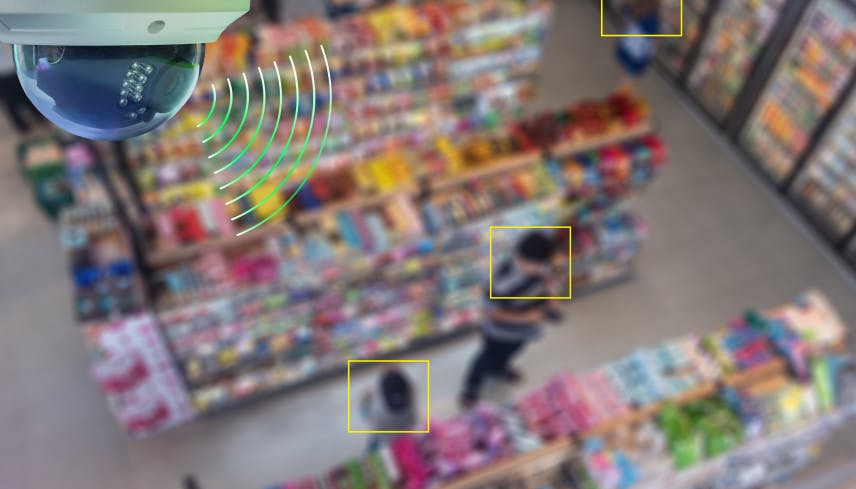
Retail intelligence refers to security solutions that gather information about your store and use it to provide actionable insights. Smart security cameras, for example, can analyze the frequency and movements captured in videos and provide insights such as:
- Number of people: Tracking the number of visitors in real-time is crucial as it helps optimize your staffing levels. By having the right amount of staff in the store, you can provide excellent customer service and reduce labor costs when foot traffic is low.
- Visitors’ profiles: AI analytics can provide insights based on demographics such as location, gender, and age, as well as customer interests, habits, and values of your customers.
- Dwell time is a metric that measures the average time a customer spends in a specific area. This area can be the entire store, a department, an aisle, or even a single product you want to monitor.
- Customer recurrence tracking is a feature that allows you to understand how often a customer visits your store weekly, monthly, or yearly. This is made possible with AI, which can recognize returning customers using facial recognition.
- Occupancy: Smart cameras can be used to monitor your store's occupancy level to ensure everyone's safety and health. Intelligent security devices can alert your store managers if the number of customers in a specific store area suddenly increases.
- Conversion rate: People counting technology allows you to accurately measure and store data on the number of people who visit your store and make a purchase.
- Queuing: Knowing that long waiting times are often detrimental to customer experience, smart retail cameras help you monitor queuing in real-time. They allow you to view peak queue times in-store, enabling you to adjust staff levels or take other countermeasures to reduce long waiting times.
- Heatmaps: What are your top-performing sales areas? The anonymous facial analysis of smart retail cameras will inform you which areas of your shop are most frequented.
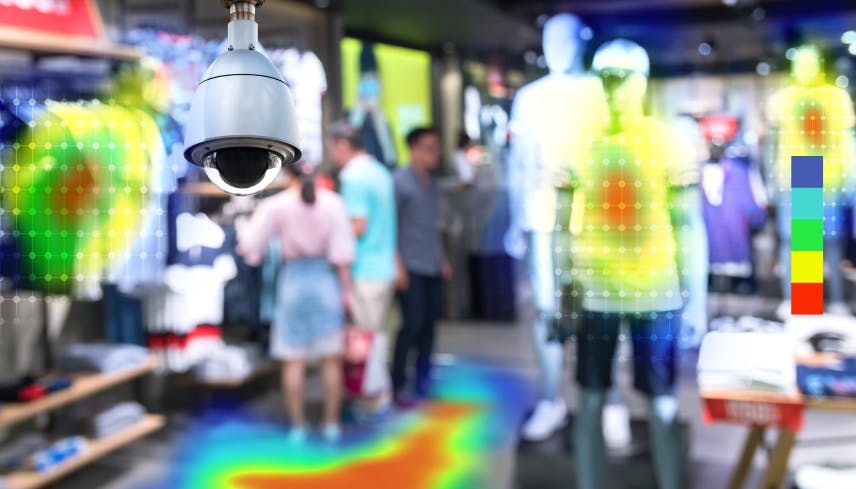
Store surveillance cameras with built-in retail intelligence capabilities allow you to use valuable data to unlock new in-store potential. These insights help you optimize customer service, merchandising, and store design in a well-informed and targeted manner.
Using AI to analyze your customers' shopping habits over the long term can help you anticipate their behavior in the future. By collecting rich customer data and using predictive analytics to evaluate it, you can improve your retail operations, fine-tune your sales strategy, and identify new business opportunities. For example, you might be able to suggest relevant products to a customer based on their past shopping patterns.
You should find a trusted and certified partner to have a successful retail security system that gives you the benefits of unified cloud platforms, efficiently helps you reduce false alarms, and enables video and access integrations. This partner should be with you for the long haul and reliably keep your cloud-based retail security solution up to date.

